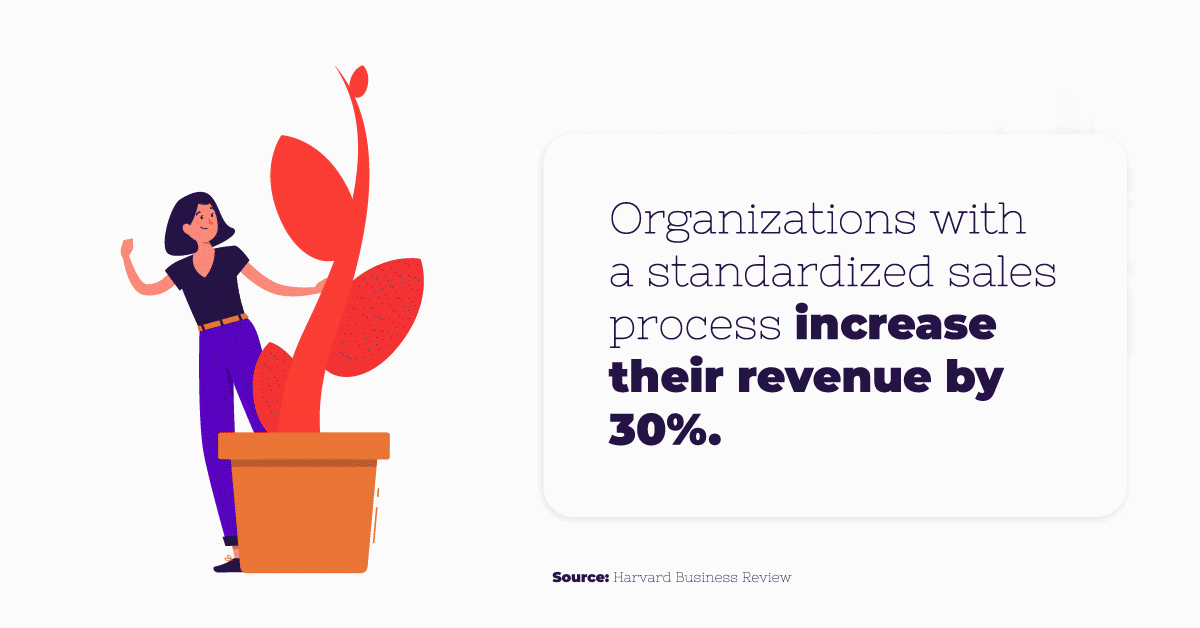Sales
The Anatomy of a Good Sales Process

Dania Alvarado
Dania Alvarado | Sep 16, 2020 | 6 MIN READ
Sep 16, 2020 6 MIN READ

Most people outside of the sales and marketing industry often associate the space with the good ‘ol Wild West. The popular belief is with a little charm, a few good connections, and the courage to shoot your shot, a salesperson would be able to close any deal. It doesn’t help that the mass media perpetuates this notion.
Unfortunately, the idea of dueling for a client without any structure is nothing more than a pipe dream. Closing a sale is more a journey than it is a boxing match. The truth is no amount of luck, charm, and courage can beat a structured sales process.
What is a Sales Process?
At its simplest, a sales process is a number of consistent steps a salesperson follows in order to take a potential customer and turn them into loyal clients. The number of steps varies from industry to industry. However, these steps should mirror the journey of the buyer from awareness to purchase.
Developing a sales process can do wonders for your business. In fact, a study from the Harvard Business Review showed that organizations that implement a standardized sales process increase their revenue by almost 30%. Consequently, 48% of the lowest-earning companies in the study do not have a clear sales process in place.
How to Create a Sales Process
Your organization’s sales methods depend on the industry your company belongs to. You can always make adjustments to improve your sales process, however, for the most part, an effective process follows the pattern below.
Determining Your Target Market
If you ask a business owner who their audience is, more often than not they reply with “everyone.” Unfortunately, casting a wide net in your marketing and sales efforts isn’t the most effective way to build a loyal client base.
Determining your target market would enable you to craft your sales pitch in an effective way. It would enable your salespeople to research and gather information about a prospect thoroughly. Identifying the customer base that you want to capture directs your resources toward leads that are more likely to convert.
Targeting the Qualified Audience
Knowing who you are talking to is key to figuring out how you should be talking to them. Think of it this way, you wouldn’t speak to a child like how you would speak to the CEO of a Fortune 500 company. Each market segment experiences different struggles, enjoys different forms of entertainment, and responds to different means of communication.
With your audience persona in tow, the next step is developing a means to communicate with your target market. You should identify where they are, how they speak, and what they care about.
For instance, if you are targeting millennials, developing your online presence is important. You must provide them with content that they care about.
Doing so would enable you to start and develop a relationship with them. While you might be actively selling just yet, you are already sowing the seeds of their future purchase.
During this stage, it is best to provide your sales team with a set of questions that they can answer in order to qualify a potential lead. Some of them might be:
- "What is your role within your company?"
- “Are you the decision-maker?”
- "What do you do day-to-day?"
- "What are your biggest challenges?"
- "Why is this a priority for your business?"
- "What other solutions are you evaluating?"
These kinds of questions can help your sales team identify if you’re talking to the right person, to understand their processes, their pain points, and their goals, and also to determine how your products or services can help to solve their problems. If it fits into a persona, then they could proceed to the next few sales process steps.
At this point in the sales process, it is a good idea to run tests on your marketing strategy. More often than not, since you already have developed your audience persona, most of your marketing tests should be successful.
Highlighting The Need for Your Product or Service
In today’s market, consumers are often diligent in gathering information about a certain product or service that they are interested in. Because their purchase decisions are guided by research, yelling a generic advertisement at them simply does not work.
The second step of this sales process allows you to attract your target market and pique their curiosity without selling to them. This next step is your opportunity to convince them that they have a need for your product. Since you have already formed a relationship, consumers are more likely to trust what you have to say.
All the information your team collects about your clients is key at this stage, your message to them should be tailor-fitted to the information that you have gathered about your lead. It should identify their specific problem, and it should connect your product’s features to solving that problem.
Closing the Deal
Business owners are often hesitant to close deals right away. It’s important to answer all of their questions promptly. According to a relevant study, it has been said that 30-35% of sales go to companies that are prompt and timely with their responses. In this case, it pays for your representatives to be online at all times and ready to respond.
Moreover, your reps are allowed to follow up with an email or a call. Determine a standard wait time in your sales process before sending follow-ups. It is best to email a lead 3 days after the presentation.
Define Your Framework
Once you're all set with the process you have created from prospecting to closing, it's now imperative to map your sales process. With a newly constructed sales process, there is no way to know if it works for your business, sales team, and customers without actually testing the waters.
By logging down notes for every step, you'll discover key performance indicators, inefficiencies, and bottlenecks, as well as understand which steps work and which don't.
Initially, it will be time-consuming but in the long run, it will help your team craft a sustainable but scalable strategy for long-term growth. After all, a strong sales process will only be able to consistently close deals if there is a solid framework to follow.
Maintaining a Relationship
Regardless of whether or not your reps bag a deal, it is important to maintain a relationship with a lead. For one, they could always change their minds so never be discouraged by a no. 80% of prospects say "no" four times before they say "yes". If they do not necessarily need your business, a pleasant interaction would most likely get your company a referral and may become an opportunity for your business.
Remaining in contact doesn’t mean a call every three days. Sending them newsletters or encouraging them to subscribe to your social channels would keep your company top-of-mind.
At the end of the day, the efficacy of your sales process doesn’t depend on how many steps you include. It is all about finding the steps that work for your company and implementing them effectively.
TABLE OF CONTENTS
Stay Updated with Our
Latest Posts
Subscribe now to receive the freshest content, insights, and updates directly in your inbox.



2024 © The Orange Box Agency – All rights reserved





.png?width=90&height=90&name=facebook%20(1).png)
.png?width=94&height=96&name=Vector%20(1).png)